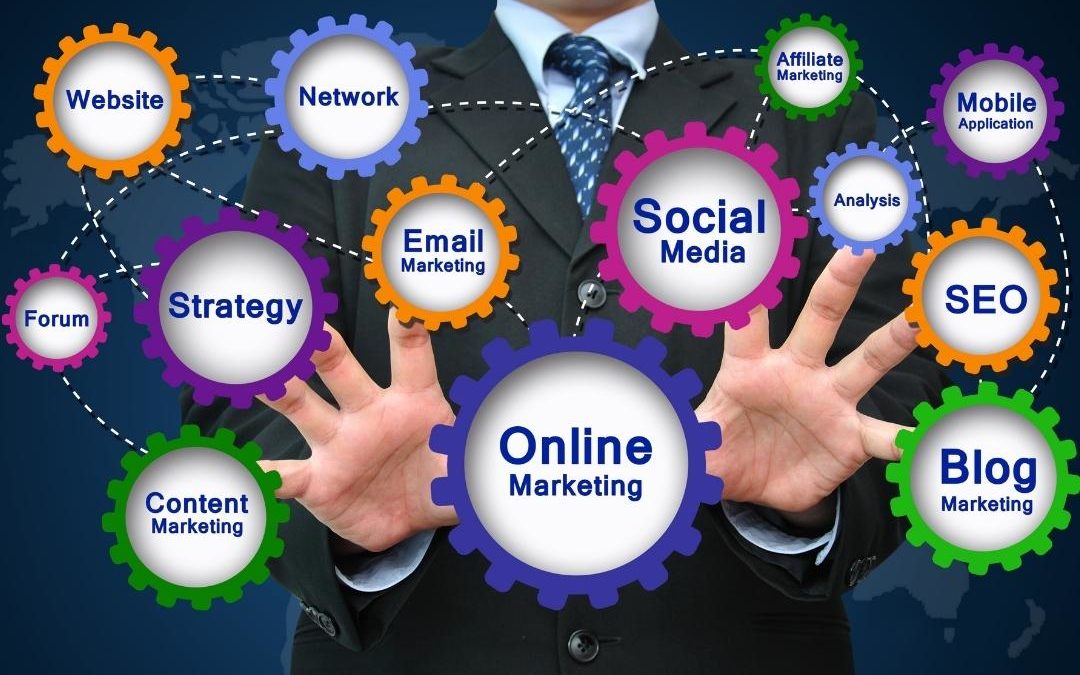Marketing is an ever-changing field, and businesses continue to find new and better ways to market themselves and their products/services.
Some marketing strategies have been around for a long time while others are new to the scene and starting to shake things up.
It’s how effectively businesses are able to combine these tactics and adapt to new ones that will take their marketing to new levels.
Here’s an overview of 10 different types of marketing strategies:
| Type of Marketing | Explanation |
|---|---|
| 📱 Social Media Marketing | Utilizes social media platforms to connect with the target audience, build brand awareness, and engage users through content, ads, and interactions. |
| 📧 Email Marketing | Involves sending targeted emails to leads and customers to nurture relationships, promote products or services, and drive conversions. |
| 🎥 Video Marketing | Leverages video content to capture attention, tell stories, demonstrate products, and entertain or educate audiences across various platforms. |
| 📰 Content Marketing | Focuses on creating and distributing valuable, relevant content to attract and retain a clearly defined audience, ultimately driving profitable customer action. |
| 🛍️ Influencer Marketing | Collaborates with influential individuals or personalities in a specific niche to promote products or services to their engaged audience. |
| 🖥️ Search Engine Marketing (SEM) | Utilizes paid advertising on search engines like Google to display ads to users searching for specific keywords, driving targeted traffic to websites. |
| 📈 Affiliate Marketing | Involves partnering with affiliates who promote products or services in exchange for a commission on sales generated through their marketing efforts. |
| 📻 Offline Marketing | Engages with customers through traditional offline channels such as print media, direct mail, billboards, and events to reach specific demographics. |
| 📊 Analytics-Driven Marketing | Relies on data analysis and insights to optimize marketing campaigns, personalize messaging, and improve overall performance based on measurable metrics. |
| 🤝 Relationship Marketing | Focuses on building and maintaining strong relationships with customers over time by providing personalized experiences, excellent customer service, and ongoing communication. |
1. Outbound Marketing
Outbound marketing, also referred to as traditional marketing, has been the most common approach for businesses in the past.
Outbound marketing includes tactics such as cold calling, cold mailing, TV ads, etc. This strategy typically sees less return on investment (ROI) due to the lack of context for the customer.
People typically aren’t looking for your product/service offer or asking for your message to be sent to them. As a result, they aren’t likely to take action or convert into a lead or customer.
That said, this method still has worked for companies and can still be viable when combined with other marketing strategies.

2. Inbound Marketing
Inbound marketing is a relatively new tactic that was brought to life largely by HubSpot. Inbound marketing is based on attracting business by being helpful and relevant to your audience rather than being interruptive.
Inbound marketing makes use of tactics like email marketing, content marketing, search engine optimization (SEO), pay-per-click advertising (PPC), and more with the focus being to attract visitors back to your website and move throughout the buyer’s journey.
The buyer’s journey is a key principle of inbound marketing along with the inbound marketing methodology.
The buyer’s journey is comprised of three stages: Awareness, Consideration, and Decision. These represent the different stages a potential customer or lead is in and how close they are to purchasing a particular product or service.
Awareness is where the majority of people coming to your site will be. This is where the buyer has identified they have a problem with which they are struggling with.
The next stage, consideration, is when the buyer is searching for different solutions to solve the problem they are struggling with.
Lastly, the decision stage is when buyers have weighed their options and are ready to choose a solution and close.
Like I mentioned previously, every tactic of inbound marketing is designed to help walk buyers throughout this journey.

The inbound marketing methodology contains four main actions: Attract, Convert, Close, and Delight as you see pictured above. This is what ties all the different aspects of inbound marketing together.
This methodology allows you to turn your marketing strategies into a repeatable process and gives purpose to everything you do from blogging to workflows.
3. Online Marketing
Online marketing refers to any marketing strategies a business may use to promote itself on the internet.
Online marketing, sometimes referred to as digital marketing, is a fairly catch-all term and includes web tactics such as social media marketing, search engine marketing, blogging, and more.
This is becoming a must for businesses in a world where having an online presence can be life or death for any given company.
4. Offline Marketing
Contrary to online marketing, offline marketing refers to any marketing strategy a business uses outside of the internet. This marketing type contains more of the traditional, or outbound, marketing tactics.
With offline marketing, businesses will use platforms like television, radio, word-of-mouth, mail, flyers, and more.
This type of marketing doesn’t have nearly the reach of online marketing but like any marketing strategy, can still be a viable option depending on the situation, who you are trying to reach, and what you are trying to accomplish.
5. Content Marketing
Content marketing is one of the core parts of inbound marketing. This includes blogging, webinars, podcasts, eBooks, and any other content you create and publish.
The competition for top-ranking content is becoming more and more crowded as more businesses develop a blog. Nonetheless, this is still an effective marketing approach and is a great platform to engage with your leads and customers.
6. Email Marketing
Another tactic featured in the inbound marketing approach is email marketing. Email marketing is the sending and automation of email campaigns to current and potential customers.
Emails can serve several different purposes. They can be automated emails sending out your latest blog post as part of an RSS feed subscription to those who have subscribed to your blog.
They can provide a targeted list with a special offer or useful information, such as an upcoming sale or confirmation of purchase.
They can help to nurture leads throughout the buyer’s journey as part of a workflow where an automated email will be sent as the result of a trigger event, or when someone takes an action on your site, and offer help or more information.
There are many uses of emails but no matter the case it’s important to make sure you allow the user to opt-out or unsubscribe in each email you send so you won’t get flagged as spam.
7. CTA Marketing
CTA, or call-to-action, marketing has a lot of overlap with other types of marketing. As you can see, calls-to-action are used everywhere.
A call-to-action is an image or button that grabs the attention of the viewer and upon clicking the link will take them to a content offer or landing page.
Blogs are very commonplace to see examples of calls-to-action both within the post itself and along the sidebar.
In fact, you can see examples of this right now being used on this page. This is a great way to provide value to your readers and get them to take an immediate next step by performing an action like downloading a content offer or scheduling a consultation.
8. Search Engine Marketing
There was a time when search engine marketing referred to both search engine optimization as well as paid search advertising.
Nowadays, search engine marketing simply refers to the latter. This term is commonly interchanged with paid search advertising or pay-per-click advertising.
Search engine marketing allows companies the chance to gain impressions and traffic to their site for keyword searches they might not have ranked for otherwise.
You can pay to advertise your web page for a given keyword search and then pay for each click to your site.
This can potentially show great ROI as you’re only paying for clicks to your site and if someone doesn’t click then you don’t pay.
However, the higher the impressions of the search result and the more difficult it is to rank for that keyword or phrase, the higher the cost-per-click (CPC) will be.
9. Social Media Marketing
Social media is a platform that keeps growing. Just look at the success that apps like Facebook and Twitter have had and continue to have.
As a result, social media marketing is relatively new in comparison to other types of marketing. Nonetheless, this is a platform that every business should be on if they aren’t already.
Social media marketing allows you to engage with your audience and reach new people outside of your audience on a regular basis. Not to mention how beneficial social media advertising can be.
You can execute advertising campaigns like boosting a post or offer on Facebook or promoting a tweet on Twitter. This will put your post in the eyes of thousands of people based on the criteria you set whether it be by location or a certain demographic.
There are numerous customization options for these types of ads and can allow you to focus your efforts on a target audience while reaching new people.
10. Event Marketing
Event marketing is a practice where businesses will host and use events to network and generate leads.
You can see examples of this all throughout the year. Take HubSpot’s annual inbound conference for instance. This attracts inbound marketers from all over every year who want to spend a couple of days networking and gathering insight from other marketers and businesses.
Having your business’s name behind an event as a host can positively impact your brand by getting your name out there and known. Depending on what the event is for, it can portray you as a thought leader in your industry or as a supporter of a good cause.
Closing:
These are just 10 of the many different types of marketing. However, these are 10 of the most prevalent that you can see businesses using regularly.
Are there any marketing types you hoped to see featured or expanded on more? Let me know down in the comments and be sure to check out some of our other blog posts for more tips and information.
Article By Nick Raineri


Pingback:9 Strategies To Market Your Ecommerce Store With Video Content - TopTut.com
Pingback:2017's Best Selling HTML Website Templates - TopTut.com